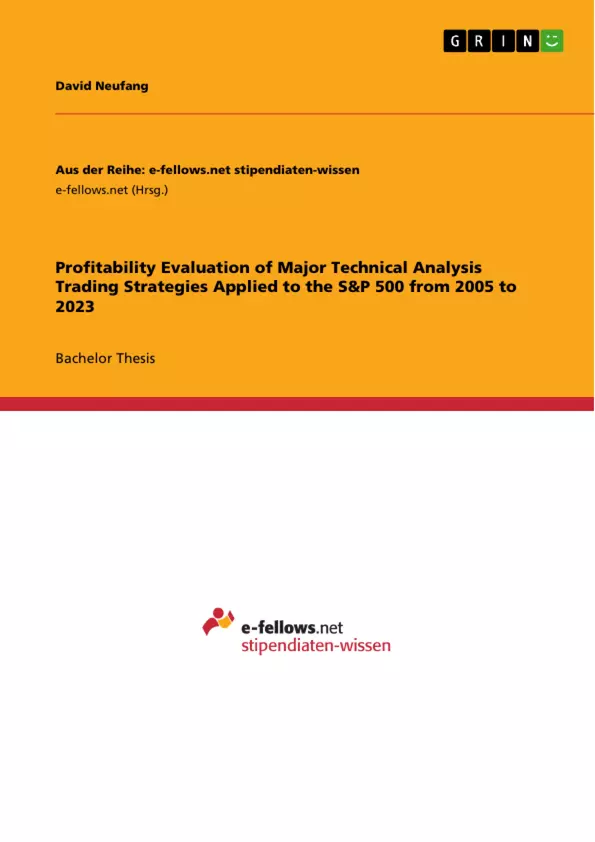This thesis will examine how the efficient market hypothesis (Fama, 1965), the random-walk hypothesis, and the Martingale model relate to the profitability of technical analysis. Additionally, relevant research on profitability up to 2023 will be presented and summarized, highlighting major findings in the context of profitability following technical trading rules. The contribution to current research is made by testing the profitability of popular technical analysis strategies and discussing the underlying reasons for any observed profitability. Furthermore, a separate analysis will be conducted, applying four technical analysis strategies to the S&P 500 time series from 2005 to 2023.
This thesis shows that none of the, in selected literature deemed profitable, trading strategies applied by Marshall (2017), Kuang et al. (2014), and Brock et al. (1992) are outperforming a S&P 500 buy-and-hold strategy between 2005 and 2023. Robustness checks such as break-even transaction cost analysis show that only two moving average variation strategies are profitable at the 20 basis points transaction cost level. Neglecting this influence of transaction costs, only one of these strategies’ returns are greater than those of a buy-and-hold strategy, though still of unsignificant nature. Nevertheless, technical analysis strategies exhibit superior performance in terms of Sharpe ratio compared to the buy-and-hold approach. This is primarily due to this thesis’ assumption of investing in risk-free treasury bills when not allocated to the S&P 500 index.
Inhaltsverzeichnis (Table of Contents)
- Introduction
- Background and Theory
- Classification of Different Technical Analysis Strategies
- Efficient Market Hypothesis
- Martingale Model
- Random Walk Models
- Augmented Dickey-Fuller Test
- Additional Models
- Literature Review
- Methodology
- Data
- Technical Analysis Strategies
- Moving Average Crossover
- Bollinger Bands
- Relative Strength Index
- Moving Average Convergence Divergence (MACD)
- Descriptive Statistics
- Underlying and Buy-and-Hold Strategy
- Strategies
- Results
- Conclusion
Zielsetzung und Themenschwerpunkte (Objectives and Key Themes)
This graduation thesis analyzes the profitability of various technical analysis strategies applied to the S&P 500 index from 2005 to 2023. The study aims to evaluate the effectiveness of these strategies in generating returns and compares their performance to a simple buy-and-hold strategy. The research considers the implications of the efficient market hypothesis and investigates the potential for market inefficiencies that technical analysis seeks to exploit.
- Profitability of Technical Analysis Strategies
- Comparison to Buy-and-Hold Strategy
- Efficient Market Hypothesis
- Market Inefficiencies
- Empirical Analysis of S&P 500 Data
Zusammenfassung der Kapitel (Chapter Summaries)
- Introduction: This chapter provides an overview of the research topic, outlining the objectives and scope of the thesis. It establishes the context for the analysis by introducing the concept of technical analysis and its role in financial markets.
- Background and Theory: This chapter delves into the theoretical foundations of technical analysis, exploring various strategies and their underlying principles. It discusses the efficient market hypothesis and its implications for the effectiveness of technical analysis. It also introduces key concepts like random walk models, the martingale model, and the augmented Dickey-Fuller test.
- Literature Review: This chapter provides a comprehensive overview of existing research on the profitability of technical analysis strategies. It examines previous studies that have investigated the effectiveness of various techniques in different market contexts.
- Methodology: This chapter outlines the data and methodology used in the study. It describes the specific technical analysis strategies implemented and the data sources employed. It also explains the statistical methods used to analyze the data and measure the performance of the strategies.
- Results: This chapter presents the findings of the empirical analysis. It discusses the profitability of the different technical analysis strategies and compares their performance to a buy-and-hold strategy. It also examines the statistical significance of the results and explores potential explanations for the observed outcomes.
Schlüsselwörter (Keywords)
The primary focus of this research lies in evaluating the profitability of various technical analysis strategies, specifically Moving Average Crossover, Bollinger Bands, Relative Strength Index, and Moving Average Convergence Divergence, applied to the S&P 500 index from 2005 to 2023. Key concepts explored include the Efficient Market Hypothesis, market inefficiencies, and the use of statistical methods to analyze financial data. The thesis also incorporates elements of descriptive statistics and risk assessment.
- Arbeit zitieren
- David Neufang (Autor:in), 2024, Profitability Evaluation of Major Technical Analysis Trading Strategies Applied to the S&P 500 from 2005 to 2023, München, GRIN Verlag, https://www.grin.com/document/1500849



